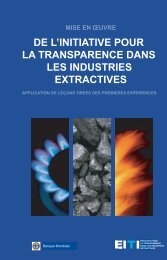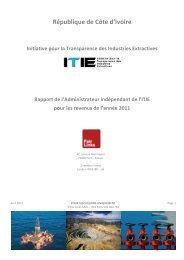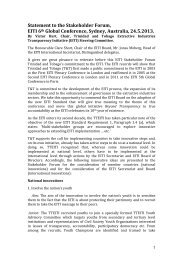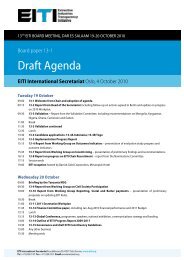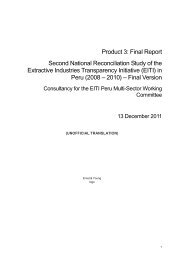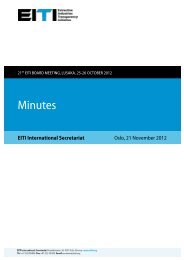EITI Business Guide
EITI Business Guide
EITI Business Guide
You also want an ePaper? Increase the reach of your titles
YUMPU automatically turns print PDFs into web optimized ePapers that Google loves.
24 <strong>EITI</strong> BusInEss GuIdE<br />
29<br />
30<br />
How can companies share lessons and guidance on the <strong>EITI</strong>?<br />
companies can communicate with headquarters and other business units; with<br />
other companies, either informally or through business associations such as IcMM,<br />
oGp and IpIEca; and with the <strong>EITI</strong> International secretariat.<br />
Individual company managers who have participated in the <strong>EITI</strong> process have a<br />
substantial amount of information and experience at their disposal and it is essential<br />
to capture this knowledge and build it into human resource processes where<br />
necessary, especially if key personnel are due to leave the company. Managers can<br />
also undertake reciprocal visits between implementing countries, as well as provide<br />
advice in countries which are not yet <strong>EITI</strong> candidate countries.<br />
In addition, as part of the validation process, the independent validator will ask<br />
the companies to comment on lessons learned and good practice examples.<br />
The validator will summarise anonymised lessons and experiences in the <strong>EITI</strong><br />
validation report.<br />
The <strong>EITI</strong> Validation Report has been published, the programme in this<br />
country has been validated, and the country is now <strong>EITI</strong> Compliant.<br />
What can my company do to go beyond compliance?<br />
The <strong>EITI</strong> is based on a principle of continuous improvement. The multi-stakeholder<br />
group can undertake regular reviews and stakeholder surveys in order to identify<br />
what more can be done to contribute to the overall goal of increased transparency.<br />
some questions to consider, and for leadership companies to raise, during the<br />
review phase include:<br />
• can more data be made publicly available on a disaggregated basis – even if<br />
this is not required by the <strong>EITI</strong> process (see Box 4, ‘Sample voluntary publication<br />
of data’)?<br />
• can more stakeholders be involved, for example smaller companies, ancillary<br />
sectors, or representatives from other natural resource industries such as<br />
forestry and fishing?<br />
• can sub-national payments be declared?<br />
• can non-production-related transactions be covered by the <strong>EITI</strong> process, for<br />
example pipeline transit fees?<br />
• is more capacity building required, e.g. for smaller companies or for civil<br />
society organisations?<br />
• is there greater public understanding of what happens to extractive industries<br />
payments and revenues? can the communications programme be made<br />
more effective?<br />
related to this last point: once there is greater transparency around how<br />
extractive industry revenues are generated and collected, there are often calls for<br />
transparency in how these revenues are distributed. While companies are not<br />
responsible for the allocation of public money, they can usefully contribute to<br />
broader discussions about how the socio-economic benefits of resource<br />
extraction can be more widely shared. one example of how companies are doing<br />
this can be seen in the mining and metals sector, through the IcMM’s resource<br />
Endowment Initiative.




